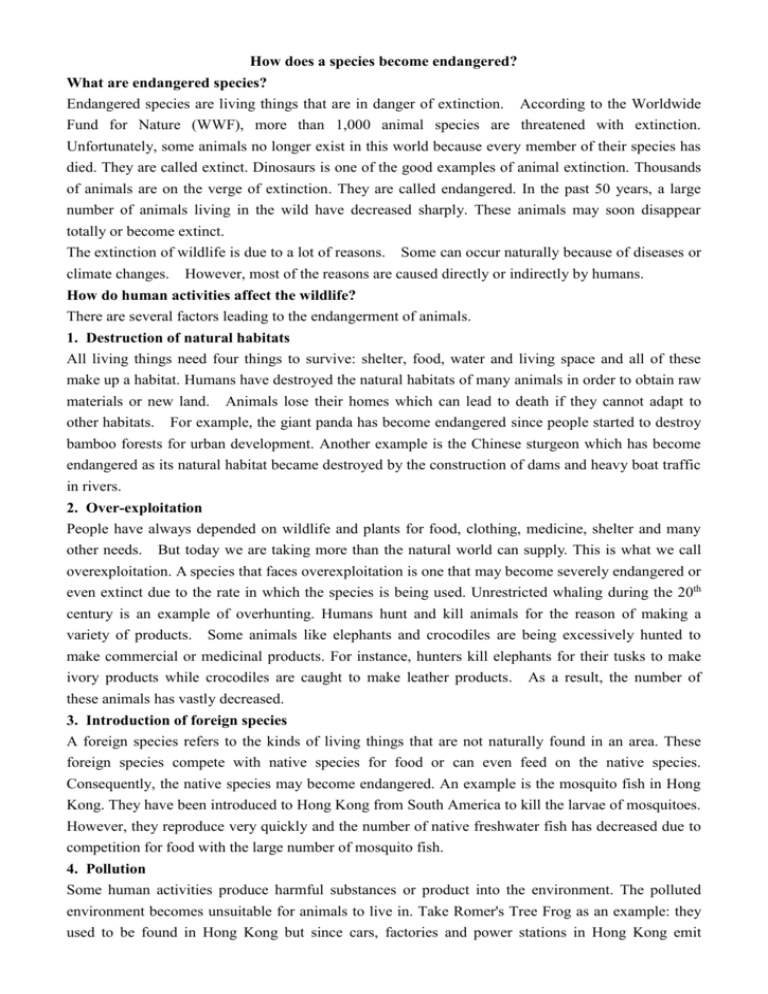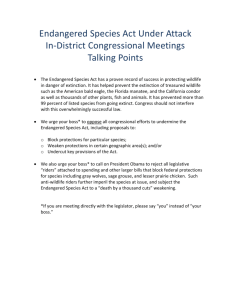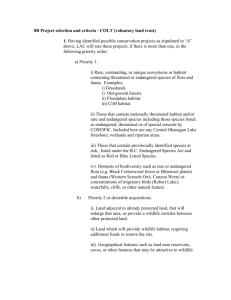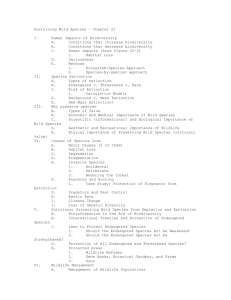How does an animal become endangered?
advertisement

How does a species become endangered? What are endangered species? Endangered species are living things that are in danger of extinction. According to the Worldwide Fund for Nature (WWF), more than 1,000 animal species are threatened with extinction. Unfortunately, some animals no longer exist in this world because every member of their species has died. They are called extinct. Dinosaurs is one of the good examples of animal extinction. Thousands of animals are on the verge of extinction. They are called endangered. In the past 50 years, a large number of animals living in the wild have decreased sharply. These animals may soon disappear totally or become extinct. The extinction of wildlife is due to a lot of reasons. Some can occur naturally because of diseases or climate changes. However, most of the reasons are caused directly or indirectly by humans. How do human activities affect the wildlife? There are several factors leading to the endangerment of animals. 1. Destruction of natural habitats All living things need four things to survive: shelter, food, water and living space and all of these make up a habitat. Humans have destroyed the natural habitats of many animals in order to obtain raw materials or new land. Animals lose their homes which can lead to death if they cannot adapt to other habitats. For example, the giant panda has become endangered since people started to destroy bamboo forests for urban development. Another example is the Chinese sturgeon which has become endangered as its natural habitat became destroyed by the construction of dams and heavy boat traffic in rivers. 2. Over-exploitation People have always depended on wildlife and plants for food, clothing, medicine, shelter and many other needs. But today we are taking more than the natural world can supply. This is what we call overexploitation. A species that faces overexploitation is one that may become severely endangered or even extinct due to the rate in which the species is being used. Unrestricted whaling during the 20th century is an example of overhunting. Humans hunt and kill animals for the reason of making a variety of products. Some animals like elephants and crocodiles are being excessively hunted to make commercial or medicinal products. For instance, hunters kill elephants for their tusks to make ivory products while crocodiles are caught to make leather products. As a result, the number of these animals has vastly decreased. 3. Introduction of foreign species A foreign species refers to the kinds of living things that are not naturally found in an area. These foreign species compete with native species for food or can even feed on the native species. Consequently, the native species may become endangered. An example is the mosquito fish in Hong Kong. They have been introduced to Hong Kong from South America to kill the larvae of mosquitoes. However, they reproduce very quickly and the number of native freshwater fish has decreased due to competition for food with the large number of mosquito fish. 4. Pollution Some human activities produce harmful substances or product into the environment. The polluted environment becomes unsuitable for animals to live in. Take Romer's Tree Frog as an example: they used to be found in Hong Kong but since cars, factories and power stations in Hong Kong emit exhaust fumes that contain harmful gases, the Romer’s Tree Frog has almost disappeared from the city. Importance of protecting wildlife All living things in a habitat interact with each other to form a stable ecosystem. They depend on each other for survival. If we take away one living thing in a habitat, it may result in the loss of other living organisms. For example, in a mangrove habitat, if people take away the crabs, the seabirds will not have enough food to eat and many of them will die. Similarly, if people clear mangroves to obtain land for urban development, crabs and seabirds will soon die out. Therefore, the conservation of wildlife and their habitats is important for our own well-being. This is because we are dependent on other living things in many ways such as for the supply of food, fuel and medicine. If more and more living things become extinct, we may face the shortage of resources for our own survival. Ways of conserving wildlife Humans have to protect wildlife because we depend on other living things for survival. Although humans have already caused a lot of plants and animals to become endangered or extinct, we can still conserve wildlife in a number of ways. Below is a list of things that humans can do to conserve wildlife: 1. Carry out studies about wildlife; with more knowledge about living things, we can find better ways to protect them. 2. Protect wildlife by laws. People should urge the government to set up measures to protect the animals. 3. Set up and manage protected areas to provide shelter to wildlife. 4. Reduce pollution. Everyone can help in reducing pollution to safeguard the suitable habitat of wildlife. 5. Educate the public to raise their awareness of environmental protection. Conclusion Due to our carelessness, many animal have been extinct or become endangered. Therefore, humans have to do something to prevent endangered animals from being extinct.








